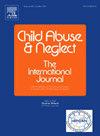Childhood adversity and intimate partner violence: A 20-year longitudinal study of cumulative, typological, and sex effects
IF 3.4
2区 心理学
Q1 FAMILY STUDIES
引用次数: 0
Abstract
Background
Adverse childhood experiences (ACEs) have been identified as risk factors for intimate partner violence (IPV). However, most studies assessed ACEs in isolation or as cumulative counts, failing to capture their synergistic and dynamic nature. Sex differences in these associations also represent critical consideration.
Objective
This study aimed to identify cumulative, typological, and time-varying effects of ACEs on IPV victimization and perpetration and examine sex-based differences in these associations.
Participants and setting
Data (N = 2078) were drawn from the National Longitudinal Study of Adolescent to Adult Health (Add Health).
Methods
We first used latent class analysis (LCA) to identify ACEs classes. Then Tobit models were used to examine the effects of varied ACEs coding schemes on IPV. Sex interactions were also tested.
Results
Cumulative ACEs were significantly associated with IPV perpetration (b = 0.220, p < .001) and victimization (b = 0.206, p < .001). Physical neglect (b = 0.808, p < .001; b = 0.752, p < .01) and physical abuse (b = 0.707, p < .001; b = 0.644, p < .01) were the strongest predictors for both IPV perpetration and victimization. LCA identified three ACEs classes; those in the Parental Abuse class had the highest IPV risk (b = 0.552, p < .01). Abuse during adolescence predicted the greatest IPV risk (b range = 0.562–0.869). Males with high ACE exposure showed greater risk of IPV victimization than females (b = 0.286, p < .01).
Conclusions
Findings point to the need for trauma-informed and sex-sensitive IPV prevention strategies.
童年逆境和亲密伴侣暴力:累积、类型和性别影响的20年纵向研究。
背景:不良童年经历(ace)已被确定为亲密伴侣暴力(IPV)的危险因素。然而,大多数研究单独评估ace或作为累积计数,未能捕捉到其协同作用和动态性质。这些关联中的性别差异也代表了重要的考虑。目的:本研究旨在确定ace对IPV受害和实施的累积、类型和时变影响,并研究这些关联的性别差异。参与者和环境:数据(N = 2078)来自国家青少年到成人健康纵向研究(Add Health)。方法:首先采用潜类分析(LCA)对ace进行分类。然后采用Tobit模型检验不同ace编码方案对IPV的影响。性互动也被测试。结果:累积性ace与IPV发生显著相关(b = 0.220, p)。结论:研究结果表明需要创伤知情和性别敏感的IPV预防策略。
本文章由计算机程序翻译,如有差异,请以英文原文为准。
求助全文
约1分钟内获得全文
求助全文
来源期刊

Child Abuse & Neglect
Multiple-
CiteScore
7.40
自引率
10.40%
发文量
397
期刊介绍:
Official Publication of the International Society for Prevention of Child Abuse and Neglect. Child Abuse & Neglect The International Journal, provides an international, multidisciplinary forum on all aspects of child abuse and neglect, with special emphasis on prevention and treatment; the scope extends further to all those aspects of life which either favor or hinder child development. While contributions will primarily be from the fields of psychology, psychiatry, social work, medicine, nursing, law enforcement, legislature, education, and anthropology, the Journal encourages the concerned lay individual and child-oriented advocate organizations to contribute.
 求助内容:
求助内容: 应助结果提醒方式:
应助结果提醒方式:


